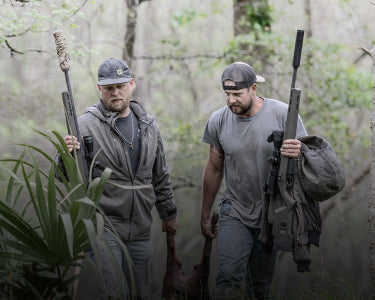Riflescopes have a fascinating history that parallels the evolution of firearms themselves. It all began centuries ago, in the 17th century, when rifling—a method of cutting spiral grooves inside the barrel of a gun to improve accuracy and range—began to gain popularity. Despite this, they didn't become widespread until years later as the manufacturing process was arduous and expensive. Rifling makes bullets spin as they travel down the barrel, increasing their stability and accuracy over longer distances. As firearms became more accurate, it became apparent that a sighting device was needed to match the newfound capabilities of the rifles they’d soon be mounted upon.
Early Innovations and the First True Riflescopes
While there were earlier attempts at developing what we know today as the modern riflescope, nothing caught on, with those early attempts amounting to a telescope used for stargazing being adapted for aiming purposes rather than true riflescopes as we know them today. The real breakthrough came in the 19th century with the development of optical lenses capable of significant magnification. With these new developments, the race was on! The first true rifle scope is credited to optician Morgan James of New York, who, assisted by John Chapman, patented his design in 1835. This new design featured fixed magnification through a series of lenses used to magnify the target while providing a clear aiming point. As exciting as this was, they were quite bulky, heavy, and often unreliable… nothing time can't fix. The following years brought about a whirlwind of transformation to Morgan’s original design, thanks to technological advances and experimentation with new materials.
Industrial Advancements and Wartime Innovation
Towards the second half of the 19th century and into the early 20th century, the advancements continued. Lenses improved in quality and clarity, and manufacturers sought to make further improvements in durability and the ability for optimal light transmission. As the 20th century drew nearer, riflescopes were becoming more common among hunters and marksmen alike. World War I spurred innovation and advancements in the world of glass as military units around the globe sought to improve the ability of their infantry units to become more accurate. At this point, the world began to see riflescopes offering features such as variable magnification, improved light transmission, and a more robust construction capable of holding up to the rigors of battle. Following WWI, the advancements continued, and by the Second World War, snipers and infantrymen considered their scopes a must-have piece of gear when going into battle. When compared to the original design, the new options being used were lighter, more durable, and at a much lower price point. If Morgan James had seen what had come of his original design at this point, he would have been amazed. Features seen now included turrets adjustable for windage and elevation, illuminated reticles for low-light shooting, and a large variety of reticle options.

A German sniper aims his Mauser Karabiner 98 Kurz outfitted with a ZF41, an early example of a scout-style riflescope with a 1.5x magnification.
The Digital Revolution and Modern Scopes
The digital age has brought on another wave of innovation in riflescope technology. Electronic components such as rangefinders, digital reticle displays, and thermal imaging sensors have been integrated into more advanced optics, offering capabilities previous generations would never have been able to imagine. Today, riflescopes are available in an endless array of designs, from compact LPVOs such as the Pinnacle 1-6x24 TMD to larger, high-powered options such as the Latitude 6.25-25x56 used for long-range precision shooting. Modern scopes use advanced optics with multiple lenses arranged in complex configurations to achieve high magnification with minimal distortion, all while trying to retain as much light transmission as possible. Through all of these advancements, we are left with riflescopes that are more reliable, durable, and optically superior to those previously manufactured.

The Wraith Mini Thermal 2-16x35 is an excellent example of a modern thermal riflescope.
Looking Ahead: The Future of Riflescopes
While our goal was to provide a brief and simple overview of how scopes have morphed from their inception to the current day, the list of features that were born along the way and the trials and tribulations of those working on bettering their design is endless. Only time can tell what advancements we may see in the future, whether it be towards a “standard” riflescope, or those involving thermal and night vision capabilities like the feature-packed Wraith Mini 2-16x35 or the Wraith 4K Max 3-24x50. From their humble beginnings centuries ago to the cutting-edge technology of today, they remain an indispensable piece of gear for shooting enthusiasts around the world.
Have a great outdoor adventure story? Share it with us! Accepted stories will receive a 20% discount code.
Frequently Asked Questions
What is the history of riflescopes?
Riflescopes have a history that dates back to the 17th century when rifling in firearms began to gain popularity, leading to the need for a sighting device to match the improved accuracy and range of rifles.
Who is credited with the invention of the first true riflescope?
Optician Morgan James of New York is credited with inventing the first true riflescope in 1835, with a design featuring fixed magnification through a series of lenses for magnifying the target and providing a clear aiming point.
How did riflescope technology evolve in the 19th and early 20th centuries?
During this period, advancements in optical lenses, quality, clarity, durability, and light transmission were made, leading to the development of features like variable magnification, improved light transmission, and more robust construction capable of withstanding the rigors of battle.
What role did World War I play in the advancement of riflescope technology?
World War I spurred innovation in glass technology, leading to improvements in riflescopes to enhance the accuracy of military units. Features like variable magnification and improved light transmission became common during this time.
What were some key features of riflescopes during World War II?
During World War II, riflescopes became essential gear for snipers and infantrymen, with features like turrets adjustable for windage and elevation, illuminated reticles, and lighter, more durable designs at a lower price point.




